Charles E W Bean, Diaries, AWM38 3DRL 606/256/1 - 1915 - 1936 - Part 10
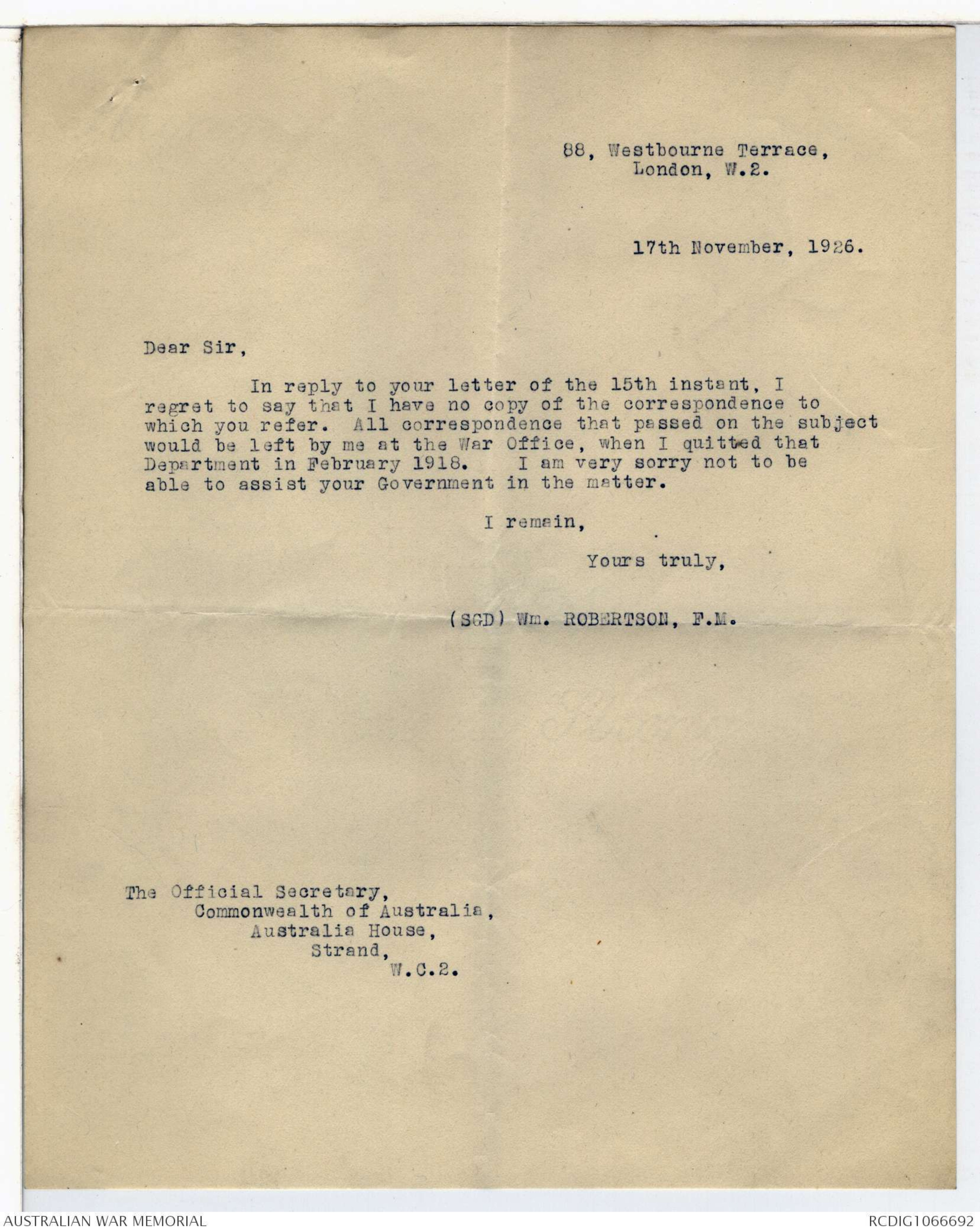
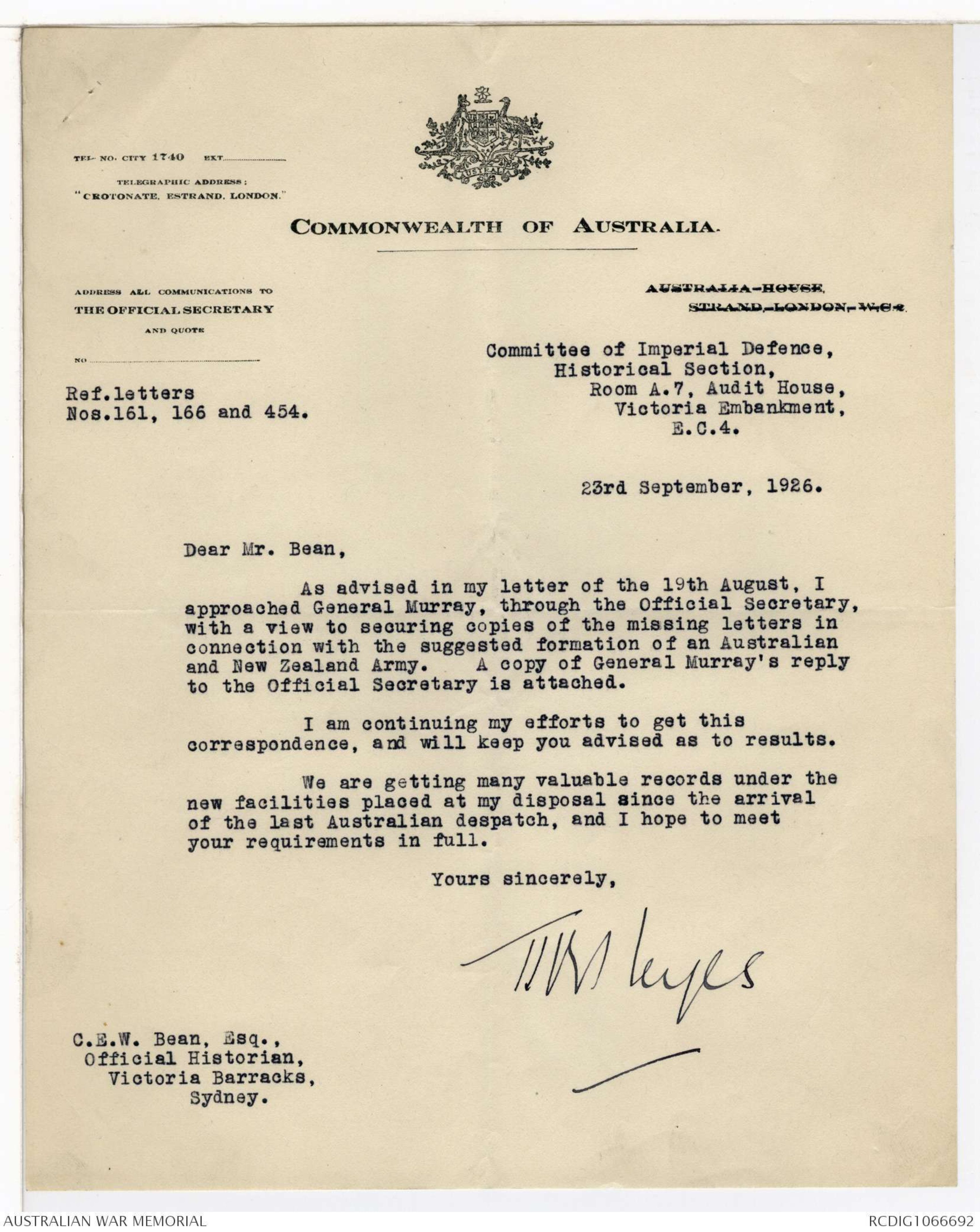
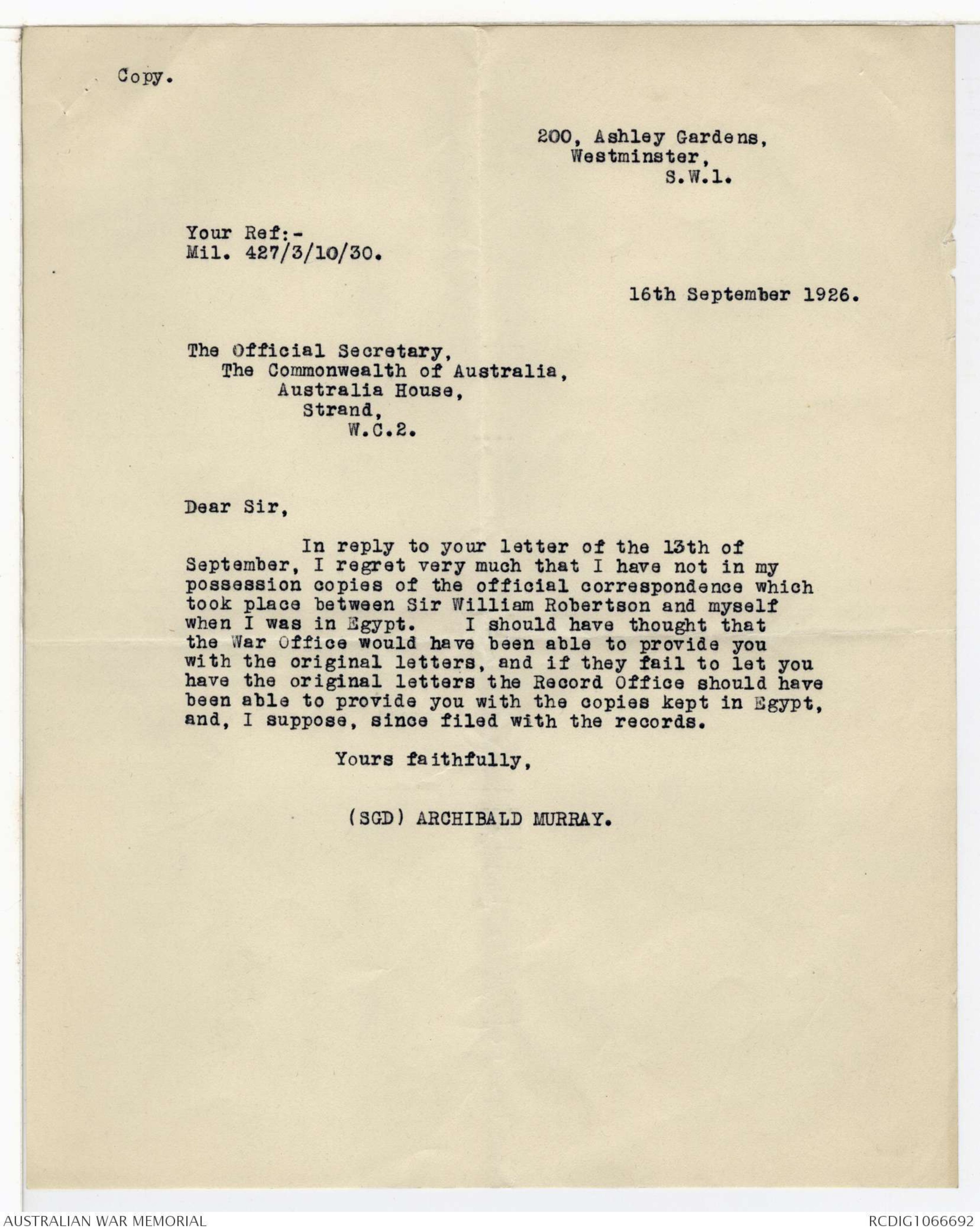
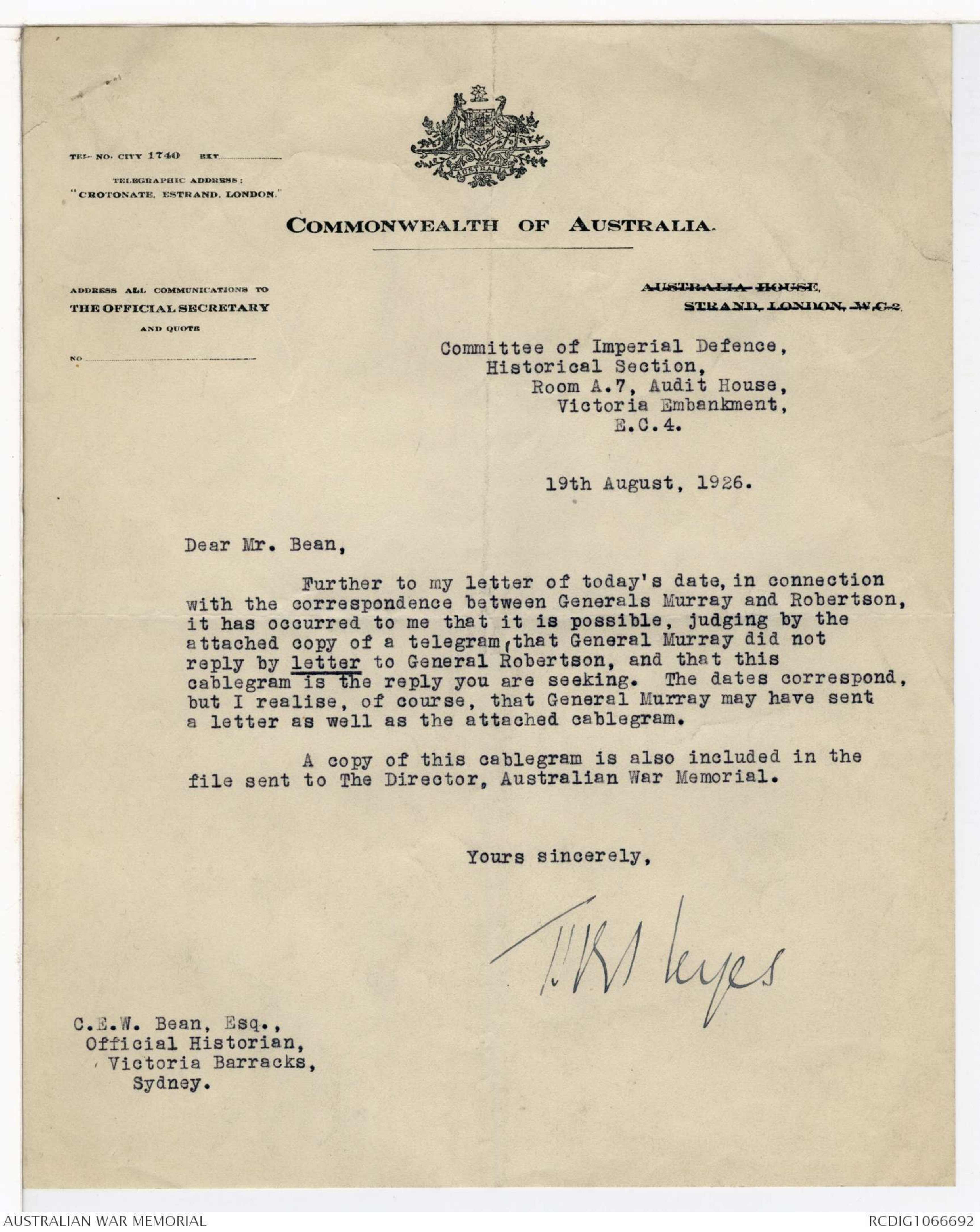

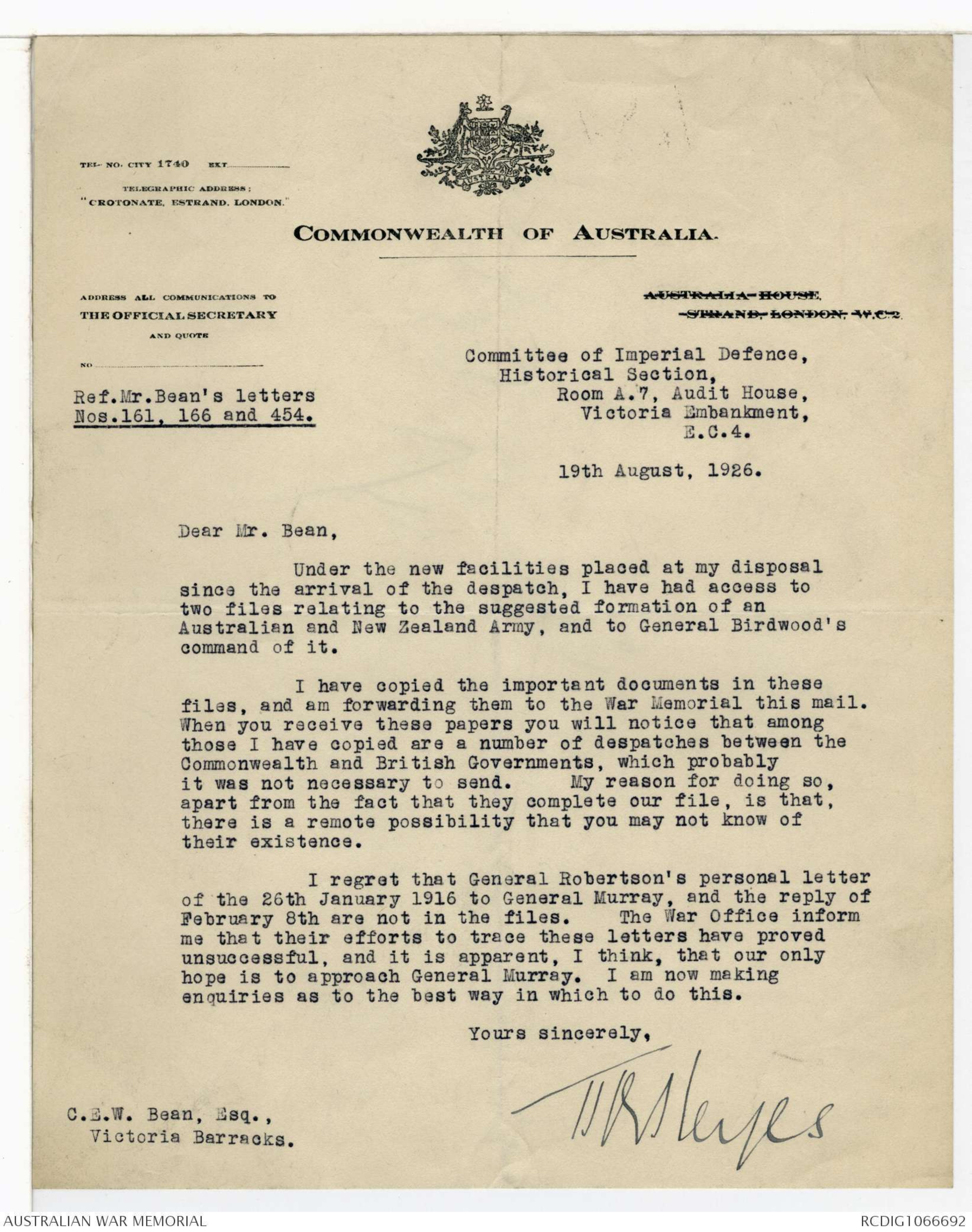
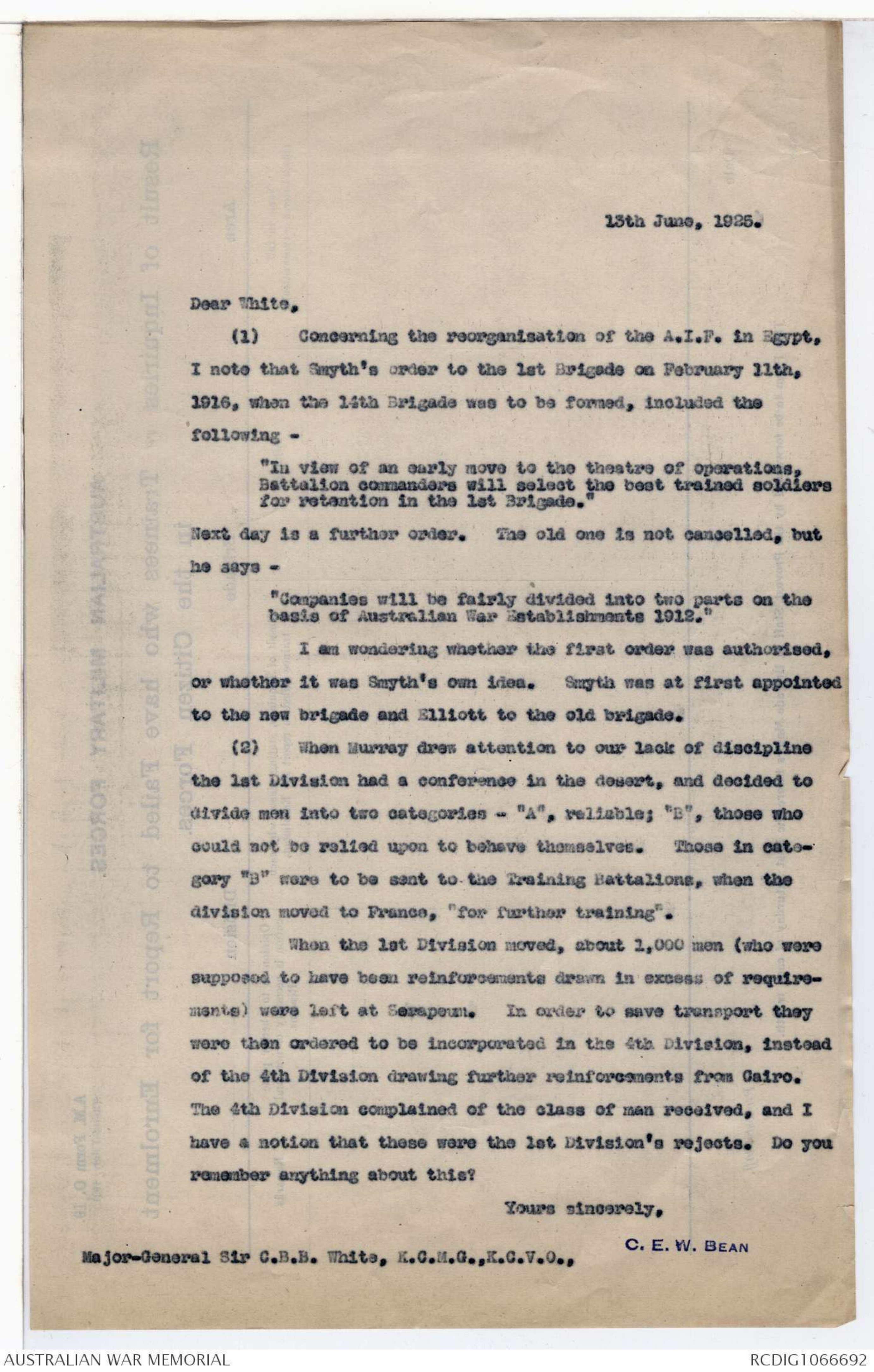
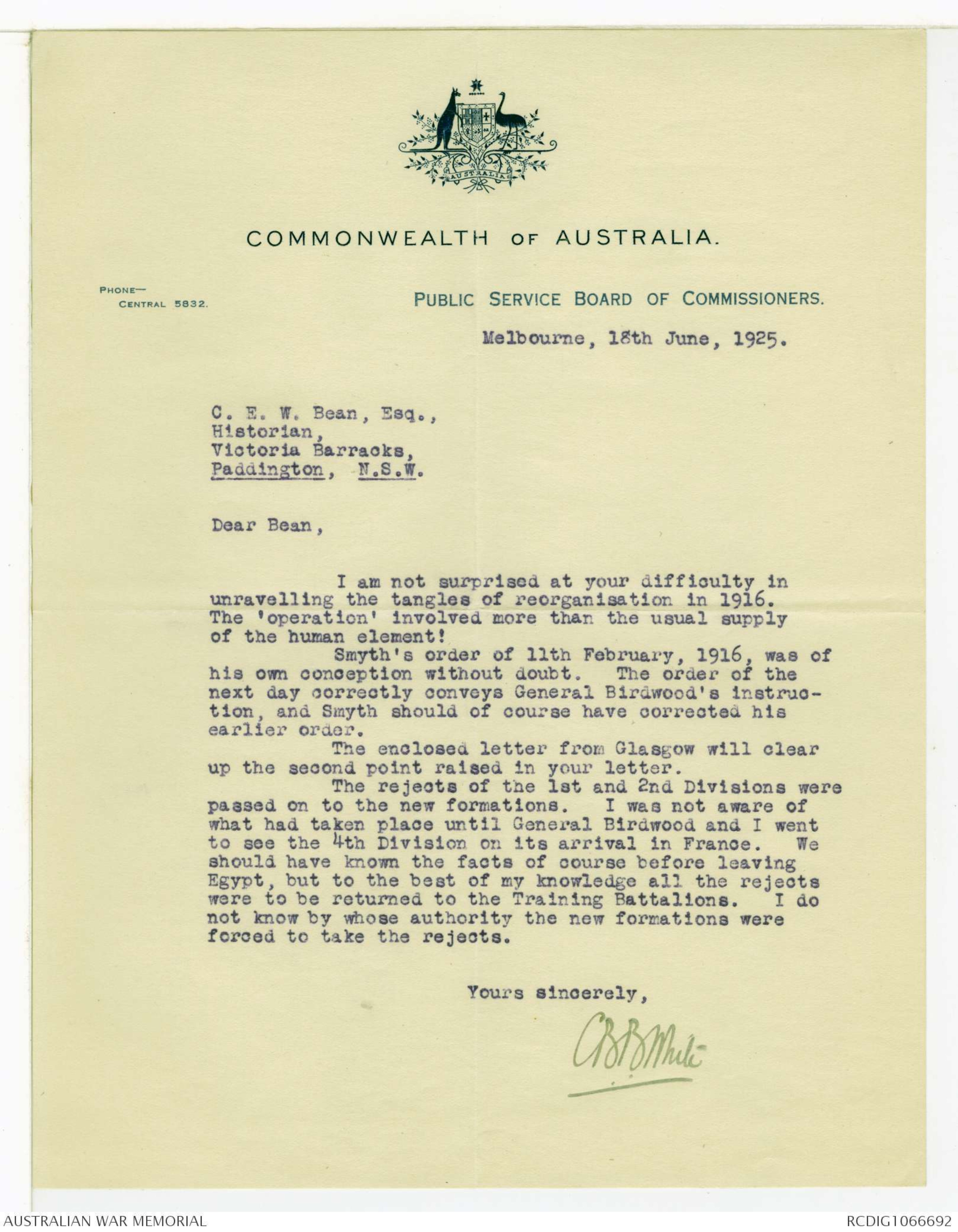
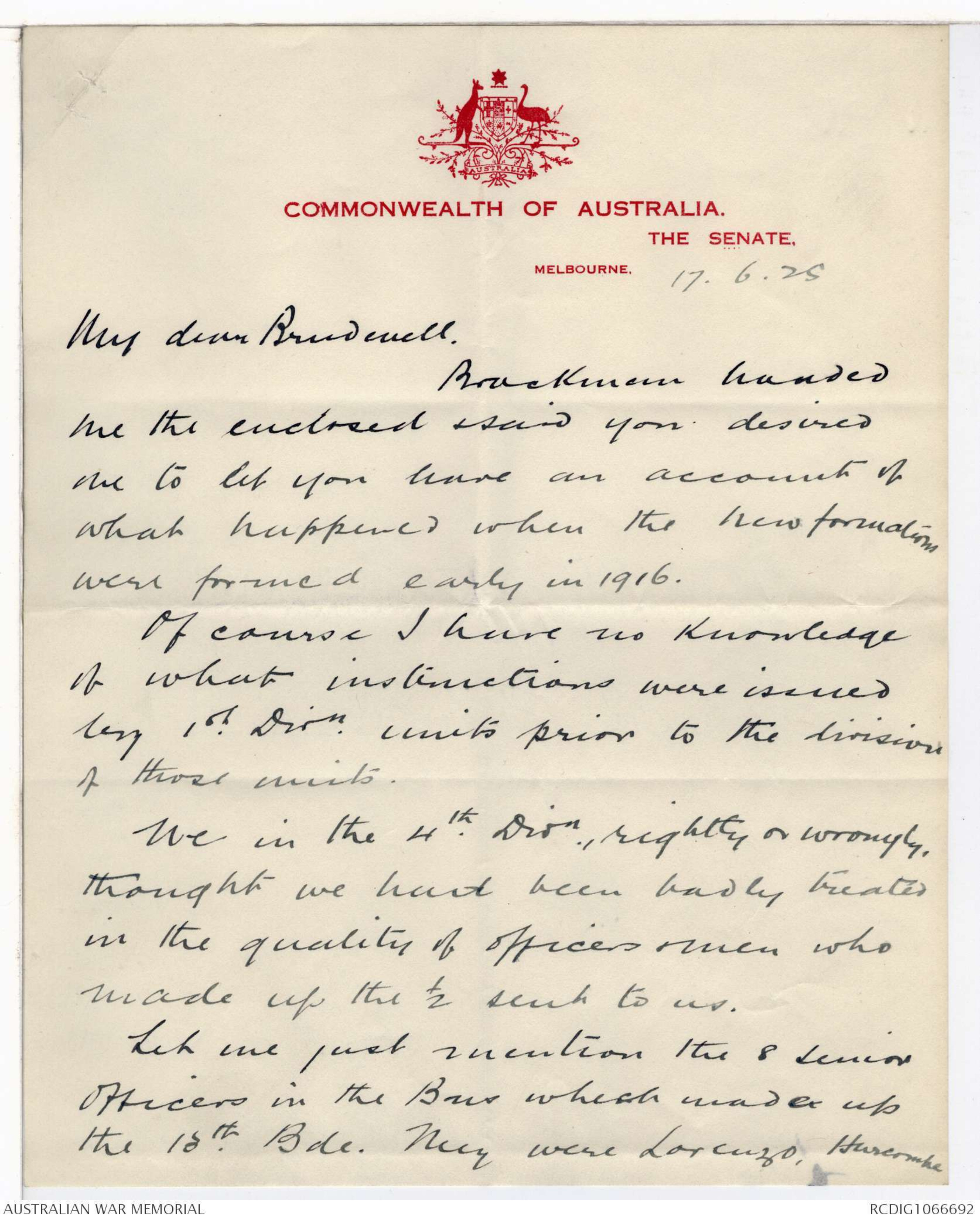
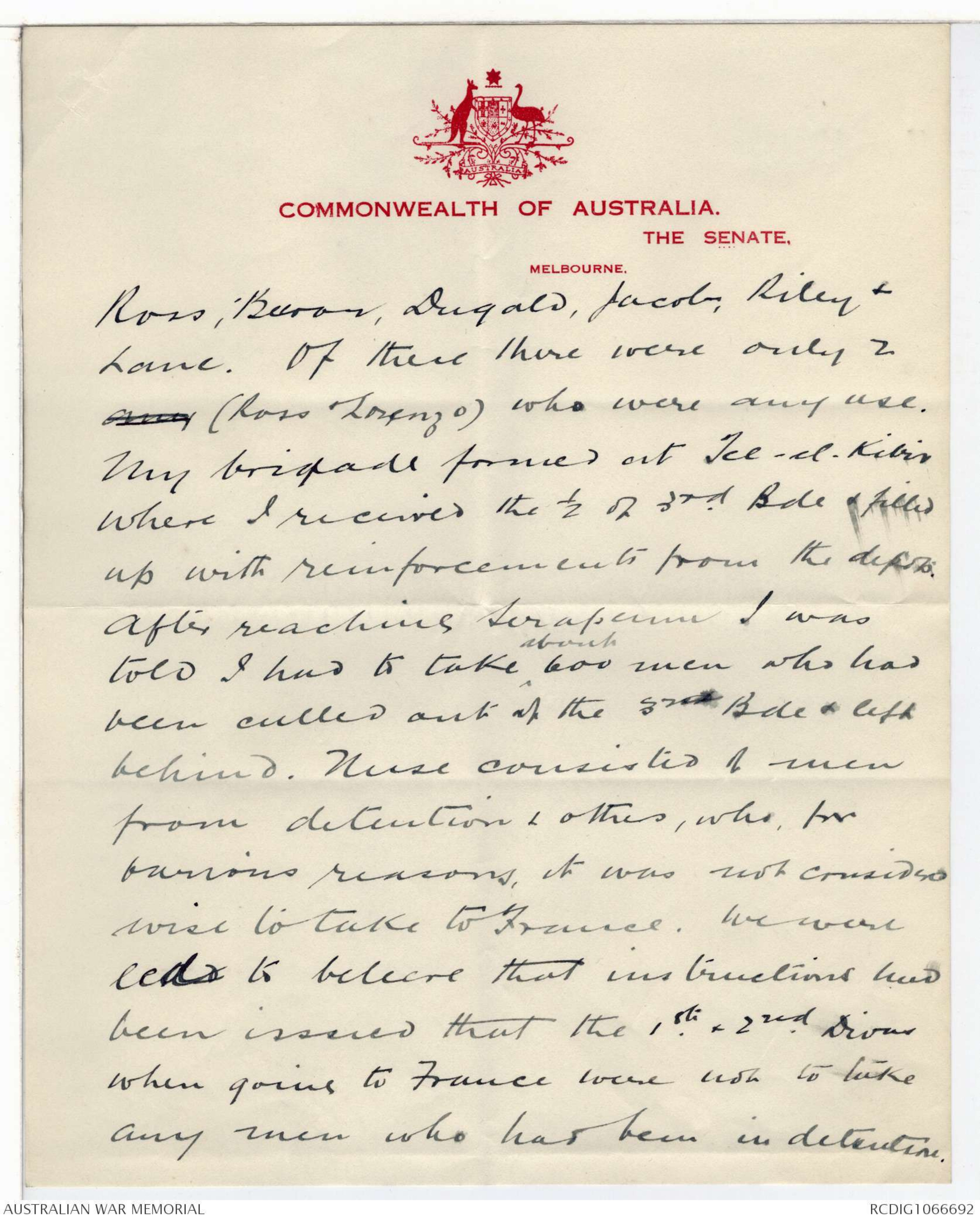
88, Westbourne Terrace,
London, W.2.
17th November, 1926.
Dear Sir,
In reply to your letter of the 15th instant, I
regret to say that I have no copy of the correspondence to
which you refer. All correspondence that passed on the subject
would be left by me at the War Office, when I quitted that
Department in February 1918. I am very sorry not to be
able to assist your Government in the matter.
I remain,
Yours truly,
(SGD) Wm. ROBERTSON, F.M.
The Official Secretary,
Commonwealth of Australia,
Australia House,
Strand,
W.C.2.
TEL. NO. CITY 1740 EXT..........
TELEGRAPHIC ADDRESS:
"CROTONATE, ESTRAND, LONDON."
COMMONWEALTH OF AUSTRALIA.AUSTRALIA HOUSE,
STRAND, LONDON, WC2
ADDRESS ALL COMMUNICATIONS TO
THE OFFICIAL SECRETARY
AND QUOTE
NO...............
Committee of Imperial Defence,
Historical Section,
Room A.7, Audit House,
Victoria Embankment,
E.C.4.
Ref. letters
Nos.161, 166 and 454.
23rd September, 1926.
Dear Mr. Bean,
As advised in my letter of the 19th August, I
approached General Murray, through the Official Secretary,
with a view to securing copies of the missing letters in
connection with the suggested formation of an Australian
and New Zealand Army. A copy of General Murray's reply
to the Official Secretary is attached.
I am continuing my efforts to get this
correspondence, and will keep you advised as to results.
We are getting many valuable records under the
new facilities placed at my disposal since the arrival
of the last Australian despatch, and I hope to meet
your requirements in full.
Yours sincerely,
T H Heyes
C.E.W. Bean, Esq.,
Official Historian,
Victoria Barracks,
Sydney.
Copy.
200, Ashley Gardens,
Westminster,
S.W.1.
Your Ref:-
Mil. 427/3/10/30.
16th September 1926.
The Official Secretary,
The Commonwealth of Australia,
Australia House,
Strand,
W.C.2.
Dear Sir,
In reply to your letter of the 13th of
September, I regret very much that I have not in my
possession copies of the official correspondence which
took place between Sir William Robertson and myself
when I was in Egypt. I should have thought that
the War Office would have been able to provide you
with the original letters, and if they fail to let you
have the original letters the Record Office should have
been able to provide you with the copies kept in Egypt,
and, I suppose, since filed with the records.
Yours faithfully,
(SGD) ARCHIBALD MURRAY.
TEL. NO. CITY 1740 EXT...............
TELEGRAPHIC ADDRESS:
"CROTONATE, ESTRAND, LONDON."
COMMONWEALTH OF AUSTRALIA.
ADDRESS ALL COMMUNICATIONS TO
THE OFFICIAL SECRETARY
AND QUOTE
NO......................AUSTRALIA HOUSE,STRAND, LONDON, W.C.2.
Committee of Imperial Defence,
Historical Section,
Room A.7, Audit House,
Victoria Embankment,
E.C.4.
19th August, 1926.
Dear Mr. Bean,
Further to my letter of today's date, in connection
with the correspondence between Generals Murray and Robertson,
it has occurred to me that it is possible, judging by the
attached copy of a telegram, that General Murray did not
reply by letter to General Robertson, and that this
cablegram is the reply you are seeking. The dates correspond,
but I realise, of course, that General Murray may have sent
a letter as well as the attached cablegram.
A copy of this cablegram is also included in the
file sent to The Director, Australian War Memorial.
Yours sincerely,
T H Heyes
C.E.W. Bean, Esq.
Official Historian,
Victoria Barracks,
Sydney.
From:- Chief, Medforce.
TO:- Chief, London.
A.M.92. 8.2.16. Desp. 1305.
Personal.
Regarding your private letter to me dated 26th
January, I shall place Birdwood in general administrative
control of all Australian Troops and in direct control
of the 1st Australian Corps with status and staff of
Corps Commander. Godley will command 2nd Corps with
similar status and staff referring certain Australian
administrative matters to Birdwood. This is necessary
as postings and promotions of all Australian Officers
must be done through Birdwood, who exercises these
functions by Commonwealth Order in Council. I have
informed Birdwood of your kind promise contained in
your last paragraph and he is not the man to raise any
protest.
TEL. NO. CITY 1740 EXT............................
TELEGRAPHIC ADDRESS:
"CROTONATE, ESTRAND, LONDON."
COMMONWEALTH OF AUSTRALIA.AUSTRALIA HOUSE,
STRAND, LONDON, W.C.2.
ADDRESS ALL COMMUNICATIONS TO
THE OFFICIAL SECRETARY
AND QUOTE
NO..........................
Ref. Mr. Bean's letters
Nos. 161, 166 and 454.
Committee of Imperial Defence,
Historical Section,
Room A.7, Audit House,
Victoria Embankment,
E.C.4.
19th August, 1926.
Dear Mr. Bean,
Under the new facilities placed at my disposal
since the arrival of the despatch, I have had access to
two files relating to the suggested formation of an
Australian and New Zealand Army, and to General Birdwood's
command of it.
I have copied the important documents in these
files, and am forwarding them to the War Memorial this mail.
When you receive these papers you will notice that among
those I have copied are a number of despatches between the
Commonwealth and British Governments, which probably
it was not necessary to send. My reason for doing so,
apart from the fact that they complete our file, is that,
there is a remote possibility that you may not know of
their existence.
I regret that General Robertson's personal letter
of the 26th January 1916 to General Murray, and the reply of
February 8th are not in the files. The War Office inform
me that their efforts to trace these letters have proved
unsuccessful, and it is apparent, I think, that our only
hope is to approach General Murray. I am now making
enquiries as to the best way in which to do this.
Yours sincerely,
T H Heyes
C.E.W. Bean, Esq.,
Victoria Barracks.
13th June, 1925.
Dear White,
(1) Concerning the reorganisation of the A.I.F. in Egypt,
I note that Smyth's order to the 1st Brigade on February 11th,
1916, when the 14th Brigade was to be formed, included the
following-
"In view of an early move to the theatre of operations,
Battalion commanders will select the best trained soldiers
for retention in the 1st Brigade."
Next day is a further order. The old one is not cancelled, but
he says -
"Companies will be fairly divided into two parts on the
basis of Australian War Establishments 1912.”
I am wondering whether the first order was authorised,
or whether it was Smyth's own idea. Smyth was at first appointed
to the new brigade and Elliott to the old brigade.
(2) When Murray drew attention to our lack of discipline
the lst Division had a conference in the desert, and decided to
divide men into two categories - "A", reliable; "B", those who
could not be relied upon to behave themselves. Those in category
"B" were to be sent to the Training Battalions, when the
division moved to France, "for further training".
When the lst Division moved, about 1,000 men (who were
supposed to have been reinforcements drawn in excess of requirements)
were left at Serapeum. In order to save transport they
were then ordered to be incorporated in the 4th Division, instead
of the 4th Division drawing further reinforcements from Cairo.
The 4th Division complained of the class of man received, and I
have a notion that these were the lst Division's rejects. Do you
remember anything about this?
Yours sincerely,
C. E. W. BEAN
Major-General Sir C.B.B. White, K.C.M.G.,K.C.V.O.,
COMMONWEALTH OF AUSTRALIA.
PHONE -
CENTRAL 5832.
PUBLIC SERVICE BOARD OF COMMISSIONERS,
Melbourne, 18th June, 1925.
C. E. W. Bean, Esq.,
Historian,
Victoria Barracks,
Paddington, N.S.W.
Dear Bean,
I am not surprised at your difficulty in
unravelling the tangles of reorganisation in 1916.
The 'operation' involved more than the usual supply
of the human element!
Smyth's order of 11th February, 1916, was of
his own conception without doubt. The order of the
next day correctly conveys General Birdwood's instruction,
and Smyth should of course have corrected his
earlier order.
The enclosed letter from Glasgow will clear
up the second point raised in your letter.
The rejects of the 1st and 2nd Divisions were
passed on to the new formations. I was not aware of
what had taken place until General Birdwood and I went
to see the 4th Division on its arrival in France. We
should have known the facts of course before leaving
Egypt, but to the best of my knowledge all the rejects
were to be returned to the Training Battalions. I do
not know by whose authority the new formations were
forced to take the rejects.
Yours sincerely,
CBB White
COMMONWEALTH OF AUSTRALIA.
THE SENATE.
MELBOURNE.
17. 6. 25
My dear Birdwell.
Brackman handed
me the enclosed & said you desired
me to let you have an account of
what happened when the new formations
were formed early in 1916.
Of course I have no knowledge
of what instructions were issued
by 1st. Divn. units prior to the division
of those units.
We in the 4th. Divn., rightly or wrongly,
thought we had been badly treated
in the quality of officers & men who
made up the ½ sent to us.
Let me just mention the 8 Senior
Officers in the Bns which made up
the 13th. Bde. They were Lorenzo, Harermke
COMMONWEALTH OF AUSTRALIA.
THE SENATE.
MELBOURNE.
Ross, Baron, Dugald, Jacobs, Riley &
Lane. Of these there were only 2xxx (Ross Lorenzo) who were any use.
My brigade formed at Tel-el-Kibir
where I received the ½ of 3rd. Bde & filled
up with reinforcements from the [[depot?]].
After reaching Serapeum I was
told I had to take ^about 6oo men who had
been culled out of the 3rd Bde & left
behind. These consisted of men
from detention & others, who for
various reasons, it was not considered
wise to take to France. We were
led to believe that instructions had
been issued that the 1st.& 2nd. Divns
when going to France were not to take
any men who had been in detention.
 Sandy Mudie
Sandy MudieThis transcription item is now locked to you for editing. To release the lock either Save your changes or Cancel.
This lock will be automatically released after 60 minutes of inactivity.